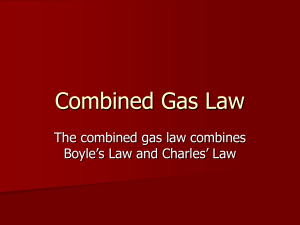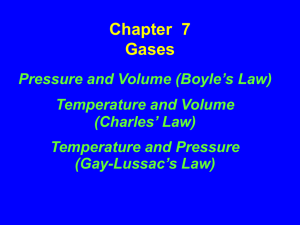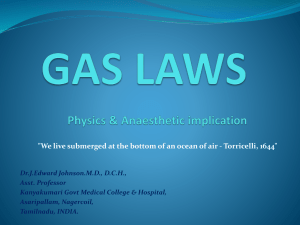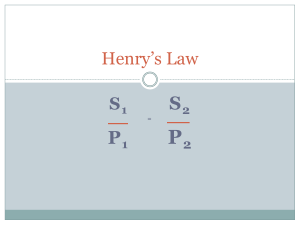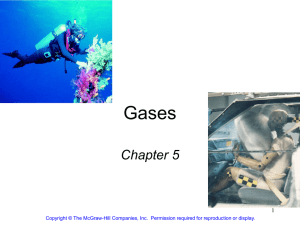File
advertisement
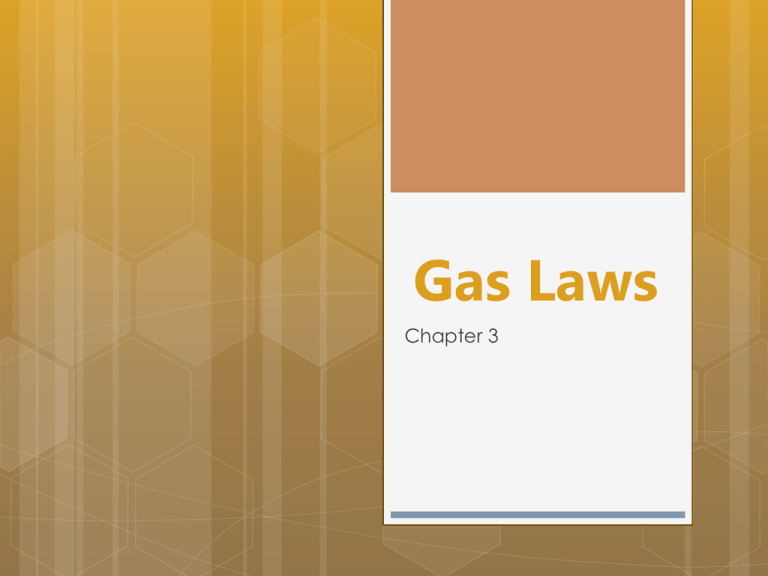
Gas Laws Chapter 3 Boyle’s Gas Law Definitions… Directly Proportional: Both variables will either increase or decrease together. Indirectly Proportional: One variable will increase and the other will decrease. Robert Boyle Studied the relationship between pressure and volume. He discovered they were inversely proportional. Boyle’s Law As the volume increases the pressure will decrease. As the volume decreases the pressure will increase. This inversely proportional relationship will only be true if the temperature and volume of the gas remain constant. What do the variables represent? P1 = Original pressure in the container V1 = Original volume in the container P2 = Final pressure in the container V2 = Final volume in the container How to Solve for Boyle’s Law… Every Boyle's Law word problem always gives you three of the four variables. Of those 3 variables, you have to determine which 2 "pair up". (Which two of the three variables were measured at the same time?) In order to get "paired" correctly, these get designated as "V1" and "P1" or "V2" and "P2". Boyle’s Law Sample Problems: A tank of nitrogen has a volume of 14.0 L and a pressure of 760.0 mmHg. Find the volume of the nitrogen when its pressure is changed to 400.0 mmHg while the temperature is held constant. How to Solve for Boyle’s Law… Step 1: Determine what you are solving for by reading the problem. What are you solving for? A tank of nitrogen has a volume of 14.0 L and a pressure of 760.0 mmHg. Find the volume of the nitrogen when its pressure is changed to 400.0 mmHg while the temperature is held constant. How to Solve for Boyle’s Law… Step 2: Determine and label which numbers are P1, V1, P2 or V2. P1 = 760 mmHg V1 = 14.0 L P2 = 400 mmHg V2 = ? How to Solve for Boyle’s Law… Step 3: Plug your numbers into your equation P1 = 760 mmHg V1 = 14.0 L P2 = 400 mmHg 760 mmHg x 14.0 L = 400 mmHg (V2) How to Solve for Boyle’s Law… 760 mmHg x 14.0 L = 400 mmHg (V2) 10640 mmHg x L = 400 mmHg (V2) How to Solve for Boyle’s Law… 760 mmHg x 14.0 L = 400 mmHg (V2) 10640 mmHg x L = 400 mmHg (V2) 10640 L = 400 x V2 How to Solve for Boyle’s Law… 760 mmHg x 14.0 L = 400 mmHg (V2) 10640 mmHg x L = 400 mmHg (V2) 10640 L = 400 x V2 400 400 How to Solve for Boyle’s Law… 760 mmHg x 14.0 L = 400 mmHg (V2) 10640 mmHg x L = 400 mmHg (V2) 10640 L = 400 x V2 400 400 How to Solve for Boyle’s Law… 760 mmHg x 14.0 L = 400 mmHg (V2) 10640 mmHg x L = 400 mmHg (V2) 10640 L = 400 x V2 400 400 V2 = 26.6 L Sample Problem #1 If I have 5.6 liters of gas in a piston at a pressure of 1.5 atm and compress the gas until its volume is 4.8 L, what will the new pressure inside the piston be? STEP 1: Read the problem and determine what you are solving for “What will the new pressure be inside the piston?” You are solving for P2 Step 2: Label your number with variables P1 = 1.5 atm V1 = 5.6 L P2 = ? V2 = 4.8 L Step 3: Plug your numbers into your equation P1 = 1.5 atm V1 = 5.6 L P2 = ? V2 = 4.8 L P1V1 = P2V2 (1.5 atm) (5.6 L) = P2 (4.8 L) Use your order of operations PEMDAS P1V1 = P2V2 (1.5 atm) (5.6 L) = P2 (4.8 L) 8.4 atm x L = P2 (4.8 L) P1V1 = P2V2 (1.5 atm) (5.6 L) = P2 (4.8 L) 8.4 atm x L = P2 (4.8 L) 8.4 atm = P2 (4.8) P1V1 = P2V2 (1.5 atm) (5.6 L) = P2 (4.8 L) 8.4 atm x L = P2 (4.8 L) 8.4 atm = P2 (4.8) 4.8 4.8 P1V1 = P2V2 (1.5 atm) (5.6 L) = P2 (4.8 L) 8.4 atm x L = P2 (4.8 L) 8.4 atm = P2 (4.8) 4.8 4.8 1.75 atm = P2 Sample Problem #2 I have added 15 L of air to a balloon at sea level (1.0 atm). If I take the balloon with me to Denver, where the air pressure is 0.85 atm, what will the new volume of the balloon be? STEP 1: Read the problem and determine what you are solving for “What will the new volume of the balloon be?” You are solving for V2 Step 2: Label your number with variables P1 = 1.0 atm V1 = 15 L P2 = 0.85 atm V2 = ? Step 3: Plug your numbers into your equation P1 = 1.0 atm V1 = 15 L P2 = 0.85 atm V2 = ? P1V1 = P2V2 (1.0 atm) (15 L) = (0.85 atm) V2 Use your order of operations PEMDAS P1V1 = P2V2 (1.0 atm) (15 L) = (0.85 atm) V2 15 atm x L = (0.85 atm) V2 P1V1 = P2V2 (1.0 atm) (15 L) = (0.85 atm) V2 15 atm x L = (0.85 atm) V2 P1V1 = P2V2 (1.0 atm) (15 L) = (0.85 atm) V2 15 atm x L = (0.85 atm) V2 15 L = (0.85) V2 P1V1 = P2V2 (1.0 atm) (15 L) = (0.85 atm) V2 15 atm x L = (0.85 atm) V2 15 L = (0.85) V2 0.85 0.85 P1V1 = P2V2 (1.0 atm) (15 L) = (0.85 atm) V2 15 atm x L = (0.85 atm) V2 15 L = (0.85) V2 0.85 0.85 17.64 L= V2 Now, work the rest on your own… Charles's Gas Law Definitions… Kinetic Molecular Theory – states that gas molecules are always in constant motion and bump into each other without loss of overall kinetic energy. This theory explains the visual properties measured by the eye and is used to understand and explain the gas laws. Jacques Charles French chemist Isolated the element Boron Studied and discovered the relationship between the temperature and volume of gases. What does Charles's Law tell us? When there is no change in pressure or the amount of gas, volume and temperature are directly related. What do the variables represent? V1/T1 = V2/T2 V1 = initial volume T1 = initial absolute temperature in Kelvin V2 = final volume T2 = final absolute temperature in Kelvin Charles’s Law examples in everyday life… When you spray a can of Lysol constantly for a short period of time, the can becomes cooler. Explanation: the liquid spray in the can is released therefore decreasing the pressure inside. Since the volume doesn’t change the temperature falls (with a decrease in pressure the temperature decreases too!!) Charles’s Law examples in everyday life… Beer or soda cans have a label on them saying “Store in a cool dry place” Explanation: When the unopened cans are exposed to direct heat or sunlight, the pressure inside the can increases. Since the volume is constant, the pressure increases to the point where it bursts letting out all the pressure Charles’s Law examples in everyday life… Leaving a basketball out in cold weather and it loses its volume or air. Once you bring the ball back into a warmer room, it will go back to its original volume. Explanation: If the pressure in the environment remains constant, then with a decrease in temperature there will be a decrease in volume. How do you solve for Charles's Law? The steps to solve Charles’s Law will be the same as those used to solve Boyle’s Law with a few exceptions. You will be given 3 variables in your problem and you will solve for the fourth variable. You will need to convert your temperatures to Kelvin and also rearrange your equation to solve for your missing variable. Charles’s Law Sample Problem… A 600 mL sample of nitrogen is heated from 27°C to 77°C at constant pressure. What is the final volume? What is Step 1? Determine what you are solving for: Final volume or V2 A 600 mL sample of nitrogen is heated from 27°C to 77°C at constant pressure. What is the final volume? What is Step 2? Determine and label which numbers are V1, T1, V2 or T2. V1 = 600 mL T1 = 27˚C V2 = ? T2 = 77˚C Since we are solving for V2, we need to rearrange our equation. V1/T1 = V2/T2 V2 = (V1)(T2) T1 Before step 3, we have to convert Celsius temperature to Kelvin. So add 273 to your Celsius temperatures: 27˚C + 273 = 300K 77˚C + 273 = 350K What is Step 3? Plug the numbers into your equation. V2 = (V1)(T2) T1 V2 = (600mL) (350K) 300K V2 = (600mL) (350K) 300K V2 = 210000 mL K 300K Get rid of your like units on the top and bottom. V2 = 210000 mL K 300K V2 = 700 mL Charles's Law Demos Egg in a bottle Ivory Soap in microwave: DO NOT ATTEMPT AT HOME!!! Why did the egg go in the bottle? Why did the egg go in the bottle… When the egg was set on the bottle, the air pressure inside the bottle matched the air pressure outside. When the burning paper was dropped into the bottle, it caused the air inside to heat up and expand rapidly. That expanding air pushed the egg aside and escaped from the bottle. When the fire consumed all the oxygen inside the bottle, the flame went out and the remaining air in the bottle cooled down. Cool air takes up less space, exerting less pressure inside the bottle. (The egg acted as a seal to prevent outside air from getting in to fill the extra space.) The force of the air pushing on the egg from outside the bottle was greater than the force of the air pushing up on it from inside the bottle. Voila - the egg was pushed into the bottle! Why did the Ivory Soap turn into a soufflé? Why did the Ivory soap turn into a soufflé… Microwave ovens send microwaves waves back and forth through your food. This causes the water, fat, and sugar molecules in the food to rotate and bump into each other, which produces heat. Ivory soap contains small pockets of air that have water vapor trapped inside of them. The water vapor inside the Ivory, heats up when the microwave is turned on. This leads to areas of high pressure inside the soap. Eventually the softened “walls” of the bar can’t hold up to the pressure and the soap starts to bubble and expand. As the soap cools down it stiffens up but keeps its new shape. Charles Gas Law Practice Problems… A balloon is filled with 3.0 L of helium at 310 K. The balloon is placed in an oven where the temperature reaches 340 K. What is the new volume of the balloon? Step 1: What are we solving for? V2 or Final volume Step 2: Label all your numbers with the correct variables The numbers in the problem are: 3.0L 310K 340K Label your numbers: V1 = 3.0 L T1 = 310K T2 = 340K Step 3: Determine which equation you are using. Since we’re solving for V2, we need to use the V2 equation. V2 = V1 T2 T1 Step 4: Plug your numbers into your equation Plug it in: V2 = V1 T2 T1 V1 = 3.0 L T1 = 310K T2 = 340K V2 = (3.0L)(340K) 310K Get rid of your like units! V2 = (3.0L)(340K) 310K V2 = 1020L 310 V2 = 3.29L A gas at 65°C occupies 4.22 L. At what Kelvin temperature will the volume be 3.87 L? Step 1: What are we solving for? T2 or Final Temperature Step 2: Label all your numbers with the correct variables The numbers in the problem are: 65°C 4.22L 3.87L Label your numbers: T1 = 65°C V1 = 4.22L V2 = 3.87L Step 3: Determine which equation you are using. Since we’re solving for final temperature, we need to use the T2 equation. T2 = V2 T1 V1 We also need to convert our temperatures to Kelvin… To convert to Kelvin, we add 273… 65°C + 273 = 338K Step 4: Plug your numbers into your equation Plug it in: T2 = V2 T1 V1 T1 = 338K V1 = 4.22L V2 = 3.87L T2 = (3.87L)(338K) 4.22L Get rid of your like units! T2 = (3.87L)(338K) 4.22L T2 = 1308K 4.22 T2 = 310K A balloon has a volume of 2500.0 mL on a day when the temperature is 50°C. If the temperature at night falls to 10.0 °C, what will be the volume of the balloon if the pressure remains constant? Step 1: What are we solving for? V2 or Final Volume Step 2: Label all your numbers with the correct variables The numbers in the problem are: 2500mL 50°C 10°C Label your numbers: V1 = 2500mL T1 = 50°C T2 = 10°C Step 3: Determine which equation you are using. Since we’re solving for final volume, we need to use the V2 equation. V2 = V1 T2 T1 We also need to convert our temperatures to Kelvin… To convert to Kelvin, we add 273… 50°C + 273 = 323K 10°C + 273 = 283K Step 4: Plug your numbers into your equation Plug it in: V2 = V1 T2 T1 V1 = 2500mL T1 = 323K T2 = 283K V2 = (2500mL)(283K) 323K Get rid of your like units! V2 = (2500mL)(283K) 323K V2 = 707500 323K V2 = 2190 mL Calculate the decrease in temperature when 2 L at 20°C is compressed to 1 L. Step 1: What are we solving for? T2 or Final temperature Step 2: Label all your numbers with the correct variables The numbers in the problem are: 2L 1L 20°C Label your numbers: V1 = 2L V2 = 1L T1 = 20°C Step 3: Determine which equation you are using. Since we’re solving for final temperature, we need to use the T2 equation. T2 = V2 T1 V1 We also need to convert our temperatures to Kelvin… To convert to Kelvin, we add 273… 20°C + 273 = 293K Step 4: Plug your numbers into your equation Plug it in: T2 = V2 T1 V1 V1 = 2L V2 = 1L T1 = 293K T2 = (1L)(293K) 2L Get rid of your like units! T2 = (1L)(293K) 2L T2 = 293K 2 V2 = 147K Homework Math Practice p. 80 #1-3 and p. 81 #9, 10


